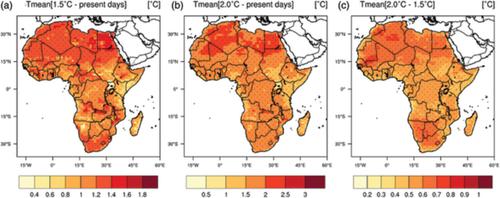当前位置:
X-MOL 学术
›
Int. J. Climatol.
›
论文详情
Our official English website, www.x-mol.net, welcomes your
feedback! (Note: you will need to create a separate account there.)
Changes in extreme temperature events over Africa under 1.5 and 2.0°C global warming scenarios
International Journal of Climatology ( IF 3.5 ) Pub Date : 2020-10-05 , DOI: 10.1002/joc.6868 Vedaste Iyakaremye 1, 2 , Gang Zeng 1 , Guwei Zhang 1
International Journal of Climatology ( IF 3.5 ) Pub Date : 2020-10-05 , DOI: 10.1002/joc.6868 Vedaste Iyakaremye 1, 2 , Gang Zeng 1 , Guwei Zhang 1
Affiliation

|
Following the December 2015 Paris Agreement, there is an international effort to limit global warming at 1.5 and 2.0°C relative to the pre‐industrial level. However, there is inadequate research quantifying the difference in extreme temperature between the two target levels, especially in Africa. This study used historical and future low‐warming projections of NCAR‐CESM to assess the differences in extreme temperature events under 1.5 and 2.0°C future scenarios relative to the recent climate taken from 1976 to 2005 over Africa. The results show that compared with the present day, the magnitude of the highest temperature (TXx) will increase by approximately 1.6/2.2°C in 1.5/2.0°C warming worlds, with more substantial warming in Sahara and Southern Africa. The lowest temperature (TNn) will increase by ∼1.9/2.5°C in 1.5/2.0°C future climates, where SAH and SAF will experience a higher intensity of warming followed by Eastern Africa and Western Africa regions. The frequency of hot days (TX90p) is projected to increase with global warming across the continent, with a high increase in SAF and SAH. The frequency of cold days (TN10p) is expected to decrease with global warming in many parts of Africa except in WAF. In most regions, there were no apparent changes revealed in the Warm Spell Duration Indicator relative to the recent climate across the continent except SAH in 1.5 and 2.0°C warming levels, while a decrease in Cold Spell Duration Indicator will be in SAH. Assessment of the avoided impacts in 1.5 relative to 2.0°C indicates that limiting global warming at 1.5 rather than 2.0°C could reduce the intensity, frequency and duration of extreme temperatures from 3 to 81%. However, the magnitude of avoided impacts differs among indices and sub‐regions. Hence, it is paramount for the African continent to limit global warming at 1.5 instead of 2.0°C.
中文翻译:

1.5和2.0°C全球变暖情景下非洲极端温度事件的变化
根据2015年12月的《巴黎协定》,国际上正在努力将全球变暖限制在相对于工业化前水平的1.5和2.0°C。但是,没有足够的研究来量化这两个目标水平之间的极端温度差异,尤其是在非洲。这项研究使用了NCAR-CESM的历史和未来低变暖预测来评估1.5和2.0°C未来情景下极端温度事件相对于1976年至2005年非洲近期气候的差异。结果表明,与今天相比,在1.5 / 2.0°C的变暖世界中,最高温度(TXx)的幅度将增加约1.6 / 2.2°C,而撒哈拉和南部非洲的变暖幅度更大。在1.5 / 2.0°C的未来气候中,最低温度(TNn)将增加约1.9 / 2.5°C,SAH和SAF的变暖强度将更高,其次是东部非洲和西部非洲地区。预计随着非洲大陆全球变暖,炎热天气的频率(TX90p)会增加,而SAF和SAH的增加会很大。随着全球变暖,除WAF以外,非洲许多地区的寒冷天数(TN10p)预计会减少。在大多数地区,除1.5和2.0°C的SAH增温水平外,相对于非洲大陆最近的气候,“暖风持续时间指标”没有发现明显的变化,而“冷风持续时间指标”的下降将是SAH。对相对于2.0°C的1.5避免影响的评估表明,将全球变暖限制在1.5而不是2.0°C可以将极端温度的强度,频率和持续时间从3%降低到81%。然而,避免影响的程度因指标和分区而异。因此,对于非洲大陆而言,将全球变暖限制在1.5而不是2.0°C是至关重要的。
更新日期:2020-10-05
中文翻译:

1.5和2.0°C全球变暖情景下非洲极端温度事件的变化
根据2015年12月的《巴黎协定》,国际上正在努力将全球变暖限制在相对于工业化前水平的1.5和2.0°C。但是,没有足够的研究来量化这两个目标水平之间的极端温度差异,尤其是在非洲。这项研究使用了NCAR-CESM的历史和未来低变暖预测来评估1.5和2.0°C未来情景下极端温度事件相对于1976年至2005年非洲近期气候的差异。结果表明,与今天相比,在1.5 / 2.0°C的变暖世界中,最高温度(TXx)的幅度将增加约1.6 / 2.2°C,而撒哈拉和南部非洲的变暖幅度更大。在1.5 / 2.0°C的未来气候中,最低温度(TNn)将增加约1.9 / 2.5°C,SAH和SAF的变暖强度将更高,其次是东部非洲和西部非洲地区。预计随着非洲大陆全球变暖,炎热天气的频率(TX90p)会增加,而SAF和SAH的增加会很大。随着全球变暖,除WAF以外,非洲许多地区的寒冷天数(TN10p)预计会减少。在大多数地区,除1.5和2.0°C的SAH增温水平外,相对于非洲大陆最近的气候,“暖风持续时间指标”没有发现明显的变化,而“冷风持续时间指标”的下降将是SAH。对相对于2.0°C的1.5避免影响的评估表明,将全球变暖限制在1.5而不是2.0°C可以将极端温度的强度,频率和持续时间从3%降低到81%。然而,避免影响的程度因指标和分区而异。因此,对于非洲大陆而言,将全球变暖限制在1.5而不是2.0°C是至关重要的。











































 京公网安备 11010802027423号
京公网安备 11010802027423号